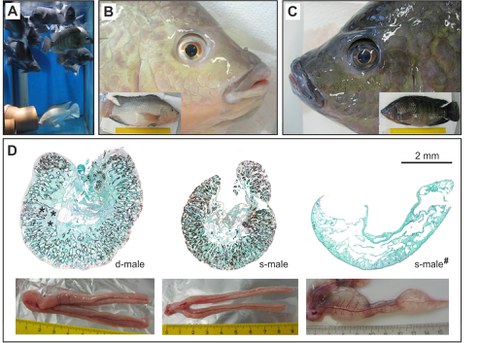Hormonal control of spermatogenesis
Another model organism in our lab is the Nile tilapia (Oreochromis niloticus). This African cichlid fish came into the focus of research to understand reproduction and physiology for effective growth in aquaculture. Additionally, O. niloticus has become a valuable model for gonad development and to study the endocrine control of spermatogenesis along the brain-pituitary-gonad (BPG) axis (see also “Perspectives in cichlid endocrinology”). The Nile tilapia was the first farmed fish with completely sequenced genome. Dominant and territorial behaviour are well known in cichlids and Nile tilapia forms long-term stable social hierarchies in the aquaria at our institute (Fig. 1A).
Territory-holding, dominant tilapia males are characterized by high plasma levels of gonadotropic and androgenic hormones. Dominant animals suppress reproduction and fertility of the subordinates (Fig. 1D). That makes Nile tilapia to an excellent model fish to elucidate how changes in social status influence the control of the reproductive axis.

(A) Photograph of a stable hierarchic community (around 15 animals, 18 months old, equal male/female ratio) in an 800 l glass tank. A pale dominant male holds a territory at the bottom of the tank. (B), (C) Body coloration and eye-darkening pattern for a dominant (B) and a subordinate male (C). Insets in B and C show the whole animal (yellow bar 30 cm). (D) Testis morphology (bottom) and histological cross-sections (top row) from the middle part of the testes and corresponding photographs of the testes (bottom row) from dominant (d-male) and subordinate males (s-male). Vasa protein (labels early germ line cells) in brown, methylene green counterstain; asterisk – large groups of Leydig cells; # - long-term suppressed s-male (loss of germ line cells).
